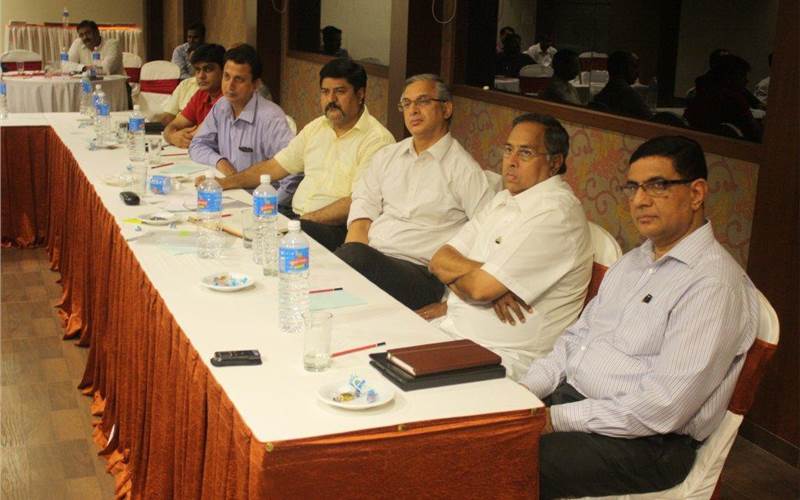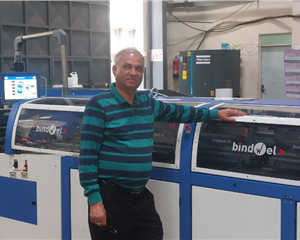Publishers and print partners: Two sides of the same coin
Leading book publishers, plus their print partners, met in Kerala to discuss the challenges faced by the printed book publishing value chain. Rahul Kumar provides a ringside view to the roundtable organised by PrintWeek India, in partnership with Henkel Adhesives and Welbound Worldwide.
04 Feb 2015 | By Rahul Kumar
The Indian book factory is a case study in transformation. From the Big Four with big budgets, producing international titles, to small, highly integrated regional titles, and tiny operations disrupting the established brands, there is something relevant for everyone. All the stakeholders agreed to this, while raising several concerns, including concerns about paper prices, piracy, unsold stocks, turnaround times, quality and retail rejections.
Above all, the concern was about the biggest bane of the Indian book industry – lack of coordination, communication and commitment.
The print CEOs agreed to most of the pain points and said these can be resolved. For this, however, they will need wholesome support from print buyers.
S Chand and MBD were the attendees who were both books publishers and printers. From the publishing segment, there were Oxford University Press, Pearson Education, HarperCollins, Taylor and Francis, Reed Elsevier India, Penguin and Hachette India. On the other hand, Replika Press, Multivista Global, Thomson Press, Manipal Technologies, Brilliant Printers, Lovely Offset, Repro India, Avantika Printers and Gopsons Paper represented the printing fraternity.
A book revolution
The print buyers of India’s leading trade and educational publishers and their print partners met in May 2014, in Thiruvananthapuram, to discuss the challenges faced by the printed book publishing value chain. The roundtable discussed the pain points in the publishing system and looked at how print partners could help.
The big challenge, as publishing consultant Subhasis Ganguli, who chaired the session, pointed out, “is the opportunity loss due to delays in printing. Then there are piracy, client confidentiality and slow-moving inventories.” Ganguli concluded that faster turnaround times (TAT) and print on demand (POD) can solve these issues.
The printers (from Repro to Manipal, and Thomson to Multivista), in turn, sought help of the publishers in better communication, best practices, standardisation, and most vociferously, better rates. The representatives of the publishers pointed out that the inefficiencies in the print process need attention. The elimination of the same can help printers reduce costs.
Kim Tagesen of Henkel Adhesives, who spoke on behalf of the equipment manufacturers and consumable suppliers, pointed out how publishers in Europe have worked with printers to eliminate wastage, enhance operational efficiencies and thereby lowering the costs in the value chain.
The moot point, according to Tagesen, was who will bear the cost in all this? “Nobody is prepared to do it,” he said. “The printers need to be paid. The publishers need to make money. This is where the discussion always fails, because we never come up with a solution. So, it’s a good idea to pay according to turnaround time. It’s the same in Europe. The cost varies with turnaround time.”
Everyone was of the view that a coming together of the stakeholders in the value chain can address most the pain points. However, it was felt that top management of the publishing companies would have to spearhead the book movement.
Partnership is the key
It was evident through the three-hour confabulation that many of the issues needed to be discussed threadbare. For this, it was imperative that the findings were presented to the publishing CEOs so that clear and collective decisions could be made.
Vasant Goel of Gopsons Papers explained it the best. “I think partnership is the key. Educating publishers in the process of printing is one aspect. It is also important that printers understand the management of publishing,” he said.
Goel added, “From the sales point of view, turnaround time becomes very critical. You believe that getting a book within a particular time period will earn you money. But, we do not know how much we are going to save. I would like to know about this from a publisher. For example, a publisher knows the printers’ cost, the plate cost, the binary cost, and so on.” This is why, to firm up the partnership, the second edition of the roundtable is being hosted during PrintPack 2015 and the New Delhi World Book Fair.
P Sajith, marketing director, Welbound Worldwide, said, “The second roundtable is an initiative by all of us to provide a common platform to book printers and publishers to discuss their pain points, views and future plans. This is because we found that most of the time, both the lobbies blame each other for the uncommonness of the business. Kerala was the first time. We feel since we do not understand each others’ problems, we do not stand together to fight it out. This makes the future of business seem difficult.”
The panel discussion in Greater Noida will see the formal formation of an Indian Book Forum in order to address the common issues and solutions for printed book publishing. According to Ganguli and Sajith, these include, standardisation of paper, raw material; the approval for new technologies (to reduce TAT); best practices methodology to improve communications; a recognition of the value of investments and specialised services and working with suppliers for efficiency enhancement.
|
Talking heads - Publishers Rakesh Mishra, Oxford University Press Paper is the biggest cost. Challenges change from time to time. During the peak season, it can be shorter turnaround time. However, as we plan much in advance, it no longer remains a challenge. So, even in case of challenges too, it comes down to the availability of paper. Turnaround time is seasonal, particularly in the Indian market, as one cannot predict sales. Suddenly, a salesperson will come and say that there is a demand at this place for these many copies. At the last second, you cannot ditch them, and thus, the turnaround time becomes crucial. Madhur Bhatia, Pearson Education Publishers want everything to be delivered in the same month, especially in case of textbooks. In such cases, scheduling and inventory planning becomes essential. When it comes to books, papers may be of different sizes. It makes standardisation difficult. Also, if the customer has to pay extra for shorter turnaround time, where does the money come from? The price of a book is fixed. Margins are fixed. Sunil Kumar, Elsevier For printers, the biggest pain point is scheduling and delivery. From the point of view of a production manager, forecasting is important. Printers must understand that the biggest cost is the loss of opportunity. Every copy in the inventory is a loss of opportunity, and if we start calculating this, it would be a huge number. From the point of view of publishers, to beat the turnaround time, there is a need for in-house standardisation, before going to the printer. Subshasis Ganguli, publishing consultant Talking about book printing, binding quality is a big concern, especially in high-level products. It is time publishers think innovatively with respect to the technologies printers are using. For example, using PUR could bring down TAT for publishers, which could help them to plan nearer to the delivery, hence improve control on inventory. With PUR, one can also get rid of excess sewing in binding. Priya Singh, Hachette India We, as publishers, are there to support you (the printers), but you have to be confident about your investment. One year down the line, I may be gone. When you started out with printing presses, it was not because I wanted you to start it. It was the confidence you had in your investment. In case of publishers, the risk involves in acquiring an author. For example, if I print 1,500 copies and cannot sell them, I cannot come back to you. That’s the way the book business functions. |
|
Talking Heads - Printers R Jayaraman, MultiVista The two major pain points remain cost and turnaround time, both of which need reduction. For us, projection comes from our salespersons. Although we have a big infrastructure, we have to value their estimates so that we can bring efficiency in the factory. But this does not happen due to the variety in products, such as textbooks, trade books and magazines. Content is the major portion of publishing, after which comes printing and others. The cost is a mixed cost. I see it as print management service. So, you have to study the entire supply chain. Rajiv Piplani, Thomson Press The way to approach it is to realise that every book that is printed is one project. So, you have thousands of projects coming out. This project has to be equally addressed by a print buyer and the printer. The problem starts when one party tries to push responsibility to another party. So, both have to understand that both contribute towards reducing the turnaround time for every book that hits the market. It starts from the moment it is conceived in the editors’ mind until the time it reaches the reader Shashiranjan, Manipal Technologies The two major pain points remain cost and turnaround time, both of which need reduction. For us, projection comes from our salespersons. Although we have a big infrastructure, we have to value their estimates so that we can bring efficiency in the factory. But this does not happen due to the variety in products, such as textbooks, trade books and magazines. Content is the major portion of publishing, after which comes printing and others. The cost is a mixed cost. I see it as print management service. So, you have to study the entire supply chain. Rajiv Vohra, Repro India There are other challenges, which are equally important. Printing security is one of them. There are 2,50,000 presses in the country and the segment is highly fragmented. Obsolesce is another biggest challenge. Stocks are kept in warehouses and it adds to the cost. One can decide on pulping only after one or two years. When you talk about partnerships, it’s a question of understanding the complete supply chain. The turnaround time is reducing. With certain technologies, we are now able to deliver within 24 hours. Think innovatively, and everything is possible. A customer gives you 20 different sizes. But is it really required? When you dig deep, you realise everything can be converted to just four different sizes. The same is with paper. You can work around it and standardise it. Anil Rego, Brilliant Printers It is a very good time for the industry. We are seeing lot of new technologies and we are working and preparing ourselves for the future. We really don’t know what’s going to happen in next five to 10 years, but for some time, both the old and new technologies are going to coexist and complement each other. I think printers must look at the entire value chain instead of looking at it separately. |
| Pain points according to publishers | How can printers help | Support sought by printers from Publishers |
| Lost opportunity is the biggest loss/cost | Faster turnaround, just in time supplies | Approval to adopt new technology, standardisation of paper, better communications, incentives for improved TAT |
| Piracy | Through quick turn arounds of fast selling books | |
| Slow moving and unsold stocks | Reduction in print runs, VMI | Prices to support ROI requirement of digital print; long term contracts |
| Cost efficiency | By reducing wastage, following best practises and working with supplier partners - become more cost efficient | Better communications on the requirement |
This feature was published on 4 February, 2015.

















 See All
See All